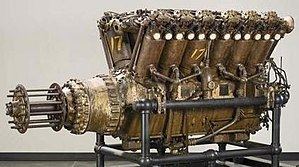The Rolls-Royce Condor aircraft piston engine was a larger version of the Rolls-Royce Eagle developing up to 675 horsepower (500 kW). The engine first ran in 1918 and a total of 327 engines were recorded as being built.
Note:
Condor I(1920-1921) 600 hp, 72 built at Derby.
Condor IAAlternative designation for Condor II.
Condor II(1921) 650 hp, revised propeller reduction gear ratio, increased compression ratio (5.17:1). 34 built at Derby.
Condor III(1923-1927) 650/670 hp, compression ratio 6.5:1, Re-designed
connecting rods. 196 built at Derby.
Condor IIIA(1925) 650/665 hp. Improved
main bearing design and material.
Condor IIIB(1930) 650 hp, 0.477:1 reduction gear, re-designed
crankcase and
crankshaft.
Condor IV(1925) 750 hp. Direct-drive, modified engine mounting. 13 built at Derby.
Condor IVA(1927) 750 hp. Nine built at Derby.
Condor V(1925) As Condor IIIA with two-stage
turbocharger. Run but not flown, one built at Derby.
Condor VIIDirect-drive Condor IIIA, two built at Derby.
Condor C.I.(1932) 480 hp, compression ignition (diesel), two engines tested and flown.
In 1932 the Air Ministry initiated a conversion of the Condor petrol engine to the compression ignition system. The conversion was developed at the Royal Aircraft Establishment, Farnborough, with the co-operation of Rolls-Royce Ltd. Engine layout, bore, and stroke remained the same as for the petrol version; the compression ratio increased to 12.5:1. The more robust construction required to withstand the increased stresses increased the engine weight to 1,504 lbs (682 kg). At its maximum 2,000 rpm the engine developed 500 hp (373 Kw), giving a power/weight ratio of 0.33 hp/lb.
The engine passed the 50-hour civil type test for compression ignition engines, being only the second British engine to do so. The only previous engine to pass this test was the much larger Beardmore Tornado fitted to the R101 airship. The diesel Condor was experimentally flown in a Hawker Horsley to explore the practical operation of a diesel engine in flight.
The Condor was used in the following aircraft:
Avro AldershotAvro AndoverAvro AvaBeardmore InflexibleBlackburn IrisBristol Berkeleyde Havilland DH.27 Derbyde Havilland DH.54 Highclerede Havilland DH.14 OkapiFairey FremantleFairey N.4Handley Page HandcrossHawker HornbillHawker HorsleyR100Rohrbach Ro V RoccoSaunders ValkyrieShort SingaporeVickers ValentiaVickers VanguardVickers VixenVickers VirginiaWestland YeovilData from Lumsden
Type: 12-cylinder liquid-cooled 60 deg. Vee aircraft piston engineBore: 5.5 in (139.7 mm)Stroke: 7.5 in (190.5 mm)Displacement: 2,137.5 in³ (35.03 L)Length: 69.3 in (1,760 mm)Width: 41.1 in (1,044 mm)Height: 43.2 in (1,097 mm)Dry weight: 1,380 lb (628 kg)Valvetrain: Overhead camshaftFuel system: 2 x Claudel-Hobson carburettorsFuel type: PetrolCooling system: Liquid-cooledPower output: 670 bhp (500 kW) at 1,900 rpmCompression ratio: 5.1:1Power-to-weight ratio: 0.48 hp/lb
